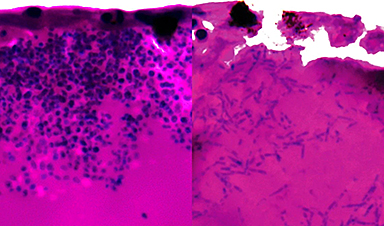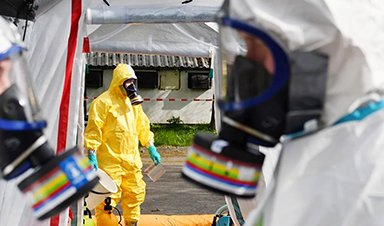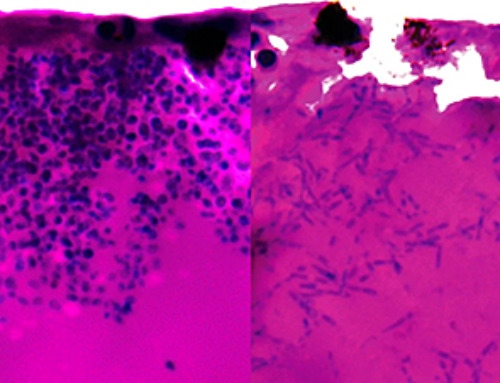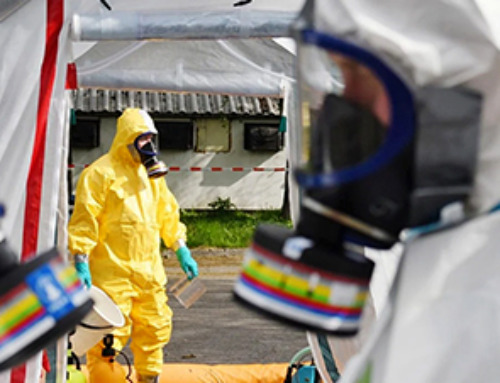A recent study reveals that an antibiotic used for liver disease patients may increase their risk of contracting a dangerous superbug.
An international team of researchers has discovered that rifaximin, a commonly prescribed antibiotic for liver disease patients, is contributing to the global rise of a highly resistant strain of vancomycin-resistant Enterococcus faecium (VRE). This superbug, which frequently causes severe infections in hospitalized patients, is becoming increasingly difficult to treat.
The study, published in Nature, reveals that rifaximin use is accelerating resistance to daptomycin—one of the last remaining effective antibiotics against VRE infections.
Led by scientists from the University of Melbourne's Peter Doherty Institute for Infection and Immunity (Doherty Institute) and Austin Health, the research underscores the urgent need for a more comprehensive understanding of the unintended consequences of antibiotic use. It highlights the critical importance of responsible antibiotic prescribing to mitigate the spread of antimicrobial resistance.
Their findings reinforce the recent political declaration of the UN General Assembly High-Level Meeting on Antimicrobial Resistance (26 Sept 2024), where world leaders committed to decisive action on antimicrobial resistance, including reducing the estimated 4.95 million AMR-associated human deaths annually by 10 per cent by 2030.
How Rifaximin Promotes Antibiotic Resistance
The eight-year study drew on several disciplines, including molecular microbiology, bioinformatics and clinical science. Using large-scale genomics – the study of an organism's DNA makeup – the scientists were able to identify changes in the DNA of daptomycin-resistant VRE that were absent in susceptible strains. Subsequent laboratory experimentation and clinical studies showed that rifaximin use caused these changes and resulted in the emergence of daptomycin-resistant VRE.
The University of Melbourne's Dr Glen Carter, a Senior Research Fellow at the Doherty Institute and senior author of the study, said the research challenges the long-held belief that rifaximin poses a 'low risk' for causing antibiotic resistance.
"We've shown that rifaximin makes VRE resistant to daptomycin in a way that has not been seen before," Dr Carter said.
"It is also of concern that these daptomycin-resistant VRE might be transmitted to other patients in the hospital; a hypothesis that we are presently investigating."
A "Supercharged" Resistance Mechanism
The University of Melbourne's Dr Adrianna Turner, a Research Officer at the Doherty Institute and first author of the study, said rifaximin triggers specific changes in an enzyme called RNA Polymerase within the bacteria. These changes "upregulate" a previously unknown gene cluster (prdRAB) leading to alterations in the VRE cell membrane and causing cross-resistance to daptomycin.
"When bacteria become resistant to an antibiotic, it's a bit like gaining a new ability in a video game, like super-speed. But when exposed to rifaximin, the VRE bacteria don't just get one boost – they gain multiple abilities, like super-speed and super-strength, allowing them to easily defeat even the final boss, which in this case is the antibiotic daptomycin," Dr Turner said.
"In other words, rifaximin doesn't just make bacteria resistant to one antibiotic; it can make them resistant to others, including critical last-resort antibiotics like daptomycin."
Associate Professor Jason Kwong, Infectious Diseases Physician at Austin Health and lead investigator of the clinical studies, emphasized two critical implications of the findings.
"Firstly, clinicians must exercise caution when treating VRE infections in patients who have been taking rifaximin, since daptomycin's efficacy may be compromised, necessitating laboratory verification before use," Associate Professor Kwong said.
"Secondly, the findings underscore the importance of regulatory bodies considering 'off-target and cross class' effects when approving new drugs. For antibiotics, this means understanding whether exposure to one agent, like rifaximin, could induce resistance against other antibiotics – even those that work differently.
"Rifaximin is still a very effective medication when used appropriately and patients with advanced liver disease who are currently taking it should continue to do so. But we need to understand the implications going forward both when treating individual patients and from a public health perspective."
The University of Melbourne's Dr Claire Gorrie, a senior bioinformatician from the Doherty Institute and co-senior author, said the research highlights how cutting-edge technologies, combined with interdisciplinary collaboration, can uncover exactly how and why bacteria develop resistance to antibiotics – even those they've never encountered.
"These insights are crucial for developing smarter, more sustainable strategies for antibiotic use, especially as these life-saving drugs become an increasingly precious resource," Dr Gorrie said.
Professor Benjamin Howden, the Director of the Microbiological Diagnostic Unit Public Health Laboratory at the Doherty Institute and an Infectious Diseases Physician at Austin Health, whose laboratory led the project, said the research will help ensure daptomycin remains an effective antibiotic for treating severe VRE infections in hospitals in Australia and around the world, particularly in the most vulnerable patients.
"Our findings highlight the critical need for effective genomics-based surveillance to detect emerging antimicrobial resistance. They also underscore the importance of judicious antibiotic use to safeguard vital last-resort treatments like daptomycin," Professor Howden concluded.
Reference: "Rifaximin prophylaxis causes resistance to the last-resort antibiotic daptomycin" by Adrianna M. Turner, Lucy Li, Ian R. Monk, Jean Y. H. Lee, Danielle J. Ingle, Stephanie Portelli, Norelle L. Sherry, Nicole Isles, Torsten Seemann, Liam K. Sharkey, Calum J. Walsh, Gavin E. Reid, Shuai Nie, Bart A. Eijkelkamp, Natasha E. Holmes, Brennan Collis, Sara Vogrin, Andreas Hiergeist, Daniela Weber, Andre Gessner, Ernst Holler, David B. Ascher, Sebastian Duchene, Nichollas E. Scott, Timothy P. Stinear, Jason C. Kwong, Claire L. Gorrie, Benjamin P. Howden and Glen P. Carter, 23 October 2024, Nature.
DOI: 10.1038/s41586-024-08095-4
The team's main collaborators were Bio21 Molecular Science and Biotechnology Institute; University Medical Center, Regensburg, Germany; The University of Queensland; and Flinders University, Adelaide.
The study was funded by the National Health and Medical Research Council.
News
We May Never Know if AI Is Conscious, Says Cambridge Philosopher
As claims about conscious AI grow louder, a Cambridge philosopher argues that we lack the evidence to know whether machines can truly be conscious, let alone morally significant. A philosopher at the University of [...]
AI Helped Scientists Stop a Virus With One Tiny Change
Using AI, researchers identified one tiny molecular interaction that viruses need to infect cells. Disrupting it stopped the virus before infection could begin. Washington State University scientists have uncovered a method to interfere with a key [...]
Deadly Hospital Fungus May Finally Have a Weakness
A deadly, drug-resistant hospital fungus may finally have a weakness—and scientists think they’ve found it. Researchers have identified a genetic process that could open the door to new treatments for a dangerous fungal infection [...]
Fever-Proof Bird Flu Variant Could Fuel the Next Pandemic
Bird flu viruses present a significant risk to humans because they can continue replicating at temperatures higher than a typical fever. Fever is one of the body’s main tools for slowing or stopping viral [...]
What could the future of nanoscience look like?
Society has a lot to thank for nanoscience. From improved health monitoring to reducing the size of electronics, scientists’ ability to delve deeper and better understand chemistry at the nanoscale has opened up numerous [...]
Scientists Melt Cancer’s Hidden “Power Hubs” and Stop Tumor Growth
Researchers discovered that in a rare kidney cancer, RNA builds droplet-like hubs that act as growth control centers inside tumor cells. By engineering a molecular switch to dissolve these hubs, they were able to halt cancer [...]
Platelet-inspired nanoparticles could improve treatment of inflammatory diseases
Scientists have developed platelet-inspired nanoparticles that deliver anti-inflammatory drugs directly to brain-computer interface implants, doubling their effectiveness. Scientists have found a way to improve the performance of brain-computer interface (BCI) electrodes by delivering anti-inflammatory drugs directly [...]
After 150 years, a new chapter in cancer therapy is finally beginning
For decades, researchers have been looking for ways to destroy cancer cells in a targeted manner without further weakening the body. But for many patients whose immune system is severely impaired by chemotherapy or radiation, [...]
Older chemical libraries show promise for fighting resistant strains of COVID-19 virus
SARS‑CoV‑2, the virus that causes COVID-19, continues to mutate, with some newer strains becoming less responsive to current antiviral treatments like Paxlovid. Now, University of California San Diego scientists and an international team of [...]
Lower doses of immunotherapy for skin cancer give better results, study suggests
According to a new study, lower doses of approved immunotherapy for malignant melanoma can give better results against tumors, while reducing side effects. This is reported by researchers at Karolinska Institutet in the Journal of the National [...]
Researchers highlight five pathways through which microplastics can harm the brain
Microplastics could be fueling neurodegenerative diseases like Alzheimer's and Parkinson's, with a new study highlighting five ways microplastics can trigger inflammation and damage in the brain. More than 57 million people live with dementia, [...]
Tiny Metal Nanodots Obliterate Cancer Cells While Largely Sparing Healthy Tissue
Scientists have developed tiny metal-oxide particles that push cancer cells past their stress limits while sparing healthy tissue. An international team led by RMIT University has developed tiny particles called nanodots, crafted from a metallic compound, [...]
Gold Nanoclusters Could Supercharge Quantum Computers
Researchers found that gold “super atoms” can behave like the atoms in top-tier quantum systems—only far easier to scale. These tiny clusters can be customized at the molecular level, offering a powerful, tunable foundation [...]
A single shot of HPV vaccine may be enough to fight cervical cancer, study finds
WASHINGTON -- A single HPV vaccination appears just as effective as two doses at preventing the viral infection that causes cervical cancer, researchers reported Wednesday. HPV, or human papillomavirus, is very common and spread [...]
New technique overcomes technological barrier in 3D brain imaging
Scientists at the Swiss Light Source SLS have succeeded in mapping a piece of brain tissue in 3D at unprecedented resolution using X-rays, non-destructively. The breakthrough overcomes a long-standing technological barrier that had limited [...]
Scientists Uncover Hidden Blood Pattern in Long COVID
Researchers found persistent microclot and NET structures in Long COVID blood that may explain long-lasting symptoms. Researchers examining Long COVID have identified a structural connection between circulating microclots and neutrophil extracellular traps (NETs). The [...]





















